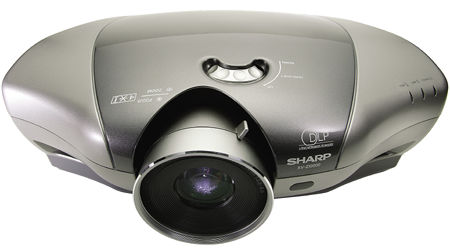Sharp XV-Z12000 DLP projector

But the Z10000 didn't sail away for some time. I put it through more than 300 hours of testing and daily use. The only negatives—if you don't count the pungent odor it emitted while operating, which disappeared after about 100 hours' use—were occasional rainbows (the Sharp fell on the better-than-average side of this drawback of single-chip DLPs), blacks that weren't the best we've seen or measured on a DLP (but they weren't far off, either), and a slight, occasional bulb flicker that turned up after 300 hours. We've seen the bulb-flicker problem on a number of other DLPs, so the Sharp was not alone here. So far, the bulb output of the new projector has been stable, and the exhaust odor, while still present, is less than what I experienced with the XV-Z10000. As we go to press, we've put about 50 hours on our XV-Z12000.
The Z10000's DVI input was also compromised because it bypassed all of the projector's standard video controls, including Brightness and Contrast, making this input essentially unusable for video sources. But its perfor-mance was so good through the component input that this shortcoming didn't bother me. The picture was pristine out of the box, but the available user adjustments made it possible to fine-tune the image even further—all without having to dive into a service menu. However, a number of these adjustments—the Color Management System and Gamma, in particular—require a color analyzer for proper use; nor did it help that their operation was poorly explained in the owner's manual.
Six HD2-chip DLP projectors passed through my studio in 2003. Some, reviewed by other SGHT contributors, I lived with for only a few days while running them through some tests. The models I reviewed myself stayed for weeks, sometimes months. But the Sharp XV-Z10000 was my favorite; it was seriously challenged only by the Marantz VP-12S2, which had slightly better blacks, and even lower susceptibility to the rainbow effect.
What's New
Compared to the XV-Z10000, the biggest change in the XV-Z12000 is the newest Digital Micromirror Device (DMD) chip from Texas Instruments, the HD2+. This differs from the HD2 chip (which was the first 12°-tilt, "black" chip used in a consumer DLP projector) in one important respect: All previous DMDs had a small "dimple" in the center of each mirror, where the support pillar is attached. Light can fall into this dimple and, through random reflections, reduce image contrast. In the HD2+ chip, the dimple is largely filled in.
Most of the new projectors that use the HD2+ chip, including this one, also incorporate a new, 7-segment, 5x color wheel. Sharp also includes an upgraded video scaler; a 3-position, remote-controllable lens iris for improved contrast (the Z10000 had a 2-position iris with no remote control); and—praise be—a DVI/HDCP input with usable Brightness and Contrast controls.
In short, Sharp has made some important changes but left the good stuff alone. I won't go into the unchanged features in detail here, as I discussed them in my reviews of the XV-Z10000 last October and November; the latter also discusses the bulb-flicker issue. Those reviews are now available online in the archive section of our website, www.guidetohometheater.com.
Firing It Up: DVD
The Sharp impressed me right out of the box, and after being calibrated it did little wrong. I would have liked a little more brightness on my Stewart FireHawk screen. With three settings of the Sharp's iris (High Contrast, Medium, High Brightness) and two bulb settings (Economy Off/On), there was no shortage of options, but ultimately I settled on Economy Off and the iris on Medium (see sidebar, "Calibration," for more on this). With a maximum peak-white level of just under 13 footlamberts viewed on-axis, I doubt if many buyers will be disappointed with the Sharp, but my 80-inch-wide screen is on the small side. When I sat (as I do) about one seat-width off-center and slightly lower than the optimum reflection point, the peak-white level at my chair dropped down to about 7.5fL. This increased to just over 10fL with a Stewart StudioTek 130, which has a wider optimum viewing angle than the FireHawk. Still, I preferred the slightly more filmlike look I got from the FireHawk-Sharp combo. The StudioTek would be an acceptable alternative for those who demand a larger screen and/or must accommodate viewers who sit much more than one seat-width off-axis.
Two improvements I'd like to see are an even more extended black level and an additional reduction in rainbow artifacts. Nevertheless, the Sharp is easily comparable to any other single-chip DLP I've seen in both respects (although it's important to note that the XV-Z12000 is the first of the HD2+ designs I've spent time with in my home theater). Rainbows did seem less noticeable than my recollection of the XV-Z10000 (not on hand for a direct comparison). I could still see them, but only rarely.
And despite my desire for more of everything (videophiles always want more), the Sharp's blacks were impressive. Not CRT-impressive—no DLP is, yet—but close. The DVD of the miniseries Taken (reviewed in this issue's "What's On?") looked deep and rich, the only flaw being a slight crushing of details in the darkest scenes. But I could always follow the action, and the image never looked washed-out.




























































